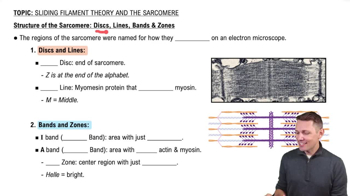Here are the essential concepts you must grasp in order to answer the question correctly.
Structure of Intervertebral Discs
Intervertebral discs are fibrocartilaginous structures located between the vertebrae in the spine. Each disc consists of two main parts: the annulus fibrosus, a tough outer layer, and the nucleus pulposus, a gel-like center. This unique structure allows the discs to absorb shock and provide flexibility to the spinal column.
Recommended video:
Structure of the Sarcomere: Bands, Zones, Discs & Lines
Shock Absorption
One of the primary functions of intervertebral discs is to absorb shock during activities such as walking, running, and jumping. The nucleus pulposus acts like a cushion, distributing pressure evenly across the disc and reducing the impact on the vertebrae. This shock-absorbing capability is crucial for protecting the spine from injury.
Recommended video:
Specialized Connective Tissue: Cartilage Example 3
Spinal Mobility
Intervertebral discs play a vital role in spinal mobility by allowing for movement between adjacent vertebrae. They enable bending, twisting, and flexing of the spine, contributing to overall flexibility. This mobility is essential for daily activities and maintaining a healthy range of motion in the back.
Recommended video:
The Pectoral Girdle Example 1
 Verified step by step guidance
Verified step by step guidance Verified Solution
Verified Solution



 6:29m
6:29m